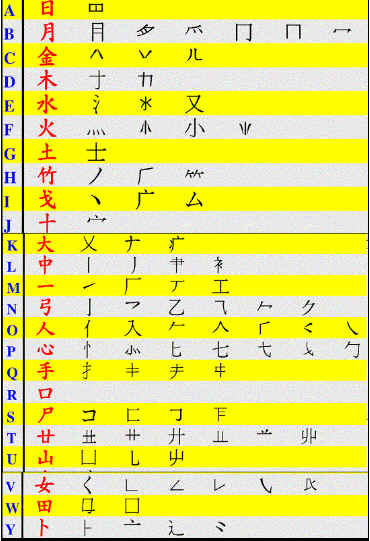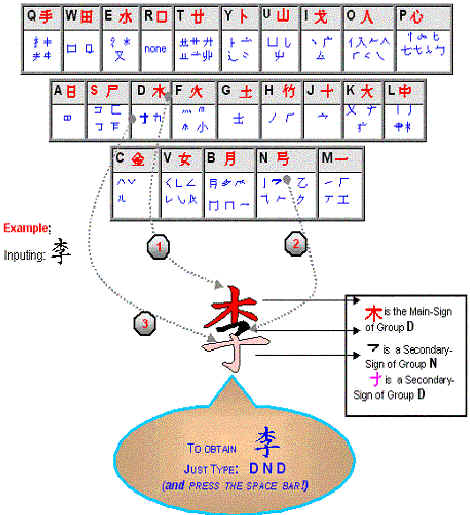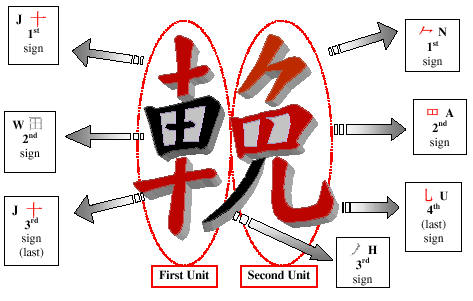STEP 4: LEARN THE SECONDARY SIGNS:
Obviously, by themselves alone, the 24 Main-Signs are not sufficient
to represent all the patterns of Chinese characters.
This is why the 87 Secondary-Signs are needed in addition to the 24 Main-Signs. Each main sign (Except the sign [口] R) is assign a small number of the 87 secondary signs to form a group. So, each of the 24 letter of the keyboard represents its corresponding Main-Sign and the derivate Secondary-Signs of the group.
It is quite easy to keep them in mind all the secondary signs because their shape derives from that of their Main-Sign, the leader of their group. Just observe each group in the table below. Most secondary signs have shapes very much related to their leader sign. (Only a few signs have less obvious morphological connection. Those must be paid more attention to remember them))
Table including: code-letter, main signs, and secondary signs:
(Any one who wishes to learn the CJ method should print this table)
Illustration: 魚 code
=NWF
The Table
below shows an imaginary keyboard where each key contains the
code-letter; the Chinese Main Sign for the group, and all the Secondary signs in
that group. It also shoes the 3 keys that will have to be type to get the
character li3 


The above table shows the keys representing the shapes of the character li3 李.
. The three difference between main signs and secondary signs:
1) all the main signs are the shape of stand alone characters while only 15 of the secondary signs represent characters. (the others represent strokes or group of stroke shapes).
2) On Chinese computer keyboards, only the main signs appear on the keys next to the letters of the alphabet. There is no space for the secondary signs --as show in the imaginary keyboard above. However, each key represents both the main sign shape and the shape of its secondary signs
3) To input a main sign, one needs only to type its corresponding key, while secondary signs that represent characters must be themselves dismantled into signs. (Examples: 廾 = JJ (十十); 小 = NC; 工= MLM; 八= HO; 入 = OH;囗 = BM). To download full list (small image file), click HERE.
There is no need to learn these 111 shapes "by
heart"!
But the student must have a good look at them and try to figure out how each
secondary sign is derived or related to its main sign. An explanation is given
in the CJ book for each secondary sign, but the student can make his/her own
explanation. The important thing is to spot them quickly inside characters and
associate them rapidly with their main sign. After practicing the relevant exercises from the CJ
book -which features many (to download two exercises, click
HERE), - and from the tutoring programs
... the secondary signs will soon pop up to the eyes by themselves! Read how to download and use the
tutor
here.
Example of Exercise on Secondary signs shapes: Guess the
corresponding main signs.

Example of the sequence to look at signs (main & secondary) in characters:

The code will not include the signs in black. The rules allowing to "skip" signs will be studied after we have seen how to delimitate the signs. (Code here is: JJNAU)
Summary of Step 4: to be able to reproduce the totality of patterns of Chinese characters, CangJie system places 87 more shapes under the lead of the 24 main signs. Secondary signs as as important to know than main signs!
Action: for the time being, just get familiarized with the shapes of the secondary signs and remembering to which main signs they are attached to. Do the two exercises on above recommended.
We will learned to spot them inside characters as soon as we have reviewed how to delimitate them and separate them form other contiguous or surrounding signs.
Next: Step 5: the delimitation of signs